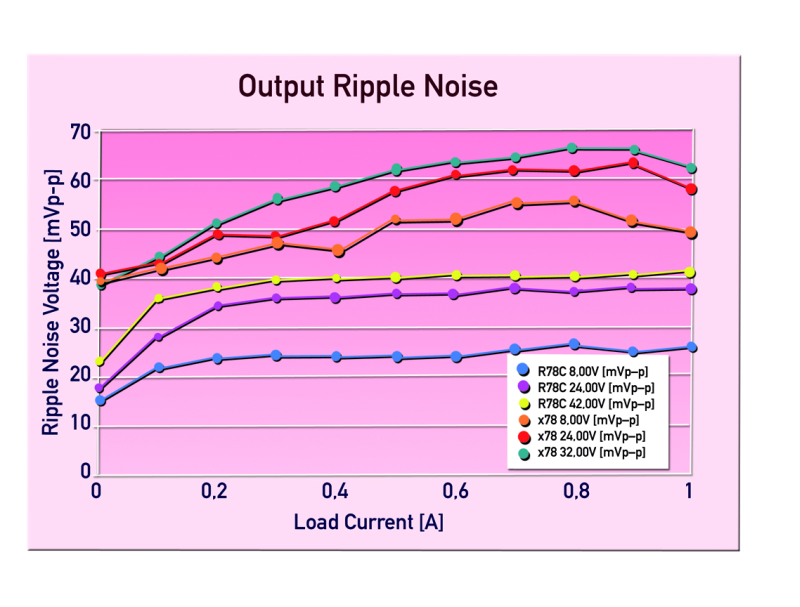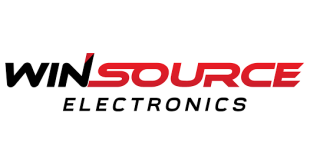 Free sample available from DENGROVE
Free sample available from DENGROVE
Linear regulators, although widely used, have a major disadvantage; inefficiency. Once input voltage rises above the drop-out threshold a linear regulator efficiency will continue to drop. Linear regulators waste energy as heat. The losses are related to the current and the voltage dropped across the regulator. Larger the voltage drop, the greater the heat generated. This heat has to be managed, usually by costly heatsinking. Switching regulators are renowned for their efficiency, with well-designed types achieving up to 97% conversion efficiency.
Advantages of Switching regulators
Linear regulators are preferred due to low price, a strong argument at high volumes. But is it? It is not a question of just the component cost, but of the energy consumption during the lifetime of operation. As soon as the input voltage widens, the efficiency starts to decline. Low efficiency translates into higher energy losses. Regulating down a voltage of 32V to 5V at 1A generates losses of 27W in a linear regulator. In the case of the Recom switching regulator type R-78C this value is reduced to 0.7W. Operating the unit daily for eight hours during 10 years accrues additional energy costs of round about £165, based on 22.85p kW h, nearly 35 times more than the original buying price of a switching regulator. As consumers become more energy aware the use of linear regulators is less attractive.
Energy loss always translates into unwanted heat, which requires management. Heatsinks cost money, plus indirect costs such as mechanical hand assembly need to be considered. Heat sinks require space and add weight. The R-78C from Recom represents a cost effective solution for the equipment manufacturer, and the end user.
Stable high efficiency with varying load
 The Recom 15V/1A regulator R-78C15-1.0 has an efficiency of 94% at 42V input and 96% at 18V input, which is just a 2% difference, no comparison to the linear regulator which remains well below 50%.
The Recom 15V/1A regulator R-78C15-1.0 has an efficiency of 94% at 42V input and 96% at 18V input, which is just a 2% difference, no comparison to the linear regulator which remains well below 50%.
The new Recom R-78C switching regulator also compares very favourably with other brands. Comparison tests with competitive 5V/1A switching regulators at 32V input and varying load put the R-78C (see opposite, blue curve) ahead with an efficiency 5-10% better (yellow curve). This may not seem significant, but the effect on losses, particularely in the medium load sector, is substantial with the R-78C generating approx. 40% less losses (red line below). The efficiency is relative constant across the most common operating load spectrum. Even with only 20% load the value exceeds 80%.
24V AC-voltage converted into a stable DC voltage
Switching regulators can operate with input voltages up to 34V, optimistically up to 36V. In theory it should be possible to rectify a 24VAC voltage and supply the converter, since the following equation applies:
24VAC*v2 = 33.9VDC
In practice however we normally deal with an unregulated voltage. If the AC voltage at the rectifier varies by only +/-10% this requires an input voltage range of up to >37VDC. This requirement could not so far be met by any switching regulator. If the AC voltage varies by +/- 20%, input voltages up to 41VDC are required. This was one reason why Recom design engineers increased the input range of the new R-78C family to 42VDC.
Standard output voltages are 1.8V, 3.3V, 5V, 9V, 12V and 15V at 1A. It is worth to mention that the R-78C switching regulators are always specified with Vin = 42V and full load – which is not true for all competitive products
Noise levels lower than expected
 Switching regulators are assumed to be electrically noisy, and are often shunned in critical applications. Recom R-78C regulators shows that this is not the case. Noise levels are between 20 and 40mVpp, depending on the model, and therefore are better by a factor 2 than the best competitive product. This was achieved by careful design, reducing noise peaks with an internal filter and by operating at a very high switching frequency of more than 400kHz. The R-78C regulators do not require additional external filters in most applications. By simply applying an external 40kHz low-pass filter, noise peaks can be further reduced down to 5mVpp. Due to their low noise design, R-78C switching regulators can be used in applications demanding very low noise levels. (see below, opposite)
Switching regulators are assumed to be electrically noisy, and are often shunned in critical applications. Recom R-78C regulators shows that this is not the case. Noise levels are between 20 and 40mVpp, depending on the model, and therefore are better by a factor 2 than the best competitive product. This was achieved by careful design, reducing noise peaks with an internal filter and by operating at a very high switching frequency of more than 400kHz. The R-78C regulators do not require additional external filters in most applications. By simply applying an external 40kHz low-pass filter, noise peaks can be further reduced down to 5mVpp. Due to their low noise design, R-78C switching regulators can be used in applications demanding very low noise levels. (see below, opposite)
High power density
 Measuring 11.6×8.6×10.4mm (H x W x D) all R-78C regulators are very compact and the power density is close to 15W/cm3. All are short circuit and overload protected. They operate in hiccup-mode until the fault is eliminated. Ambient temperature is specified -40°C and +85°C, whereby derating has to be observed at the upper limit. Thermal overload protection switches the regulator off, until a pre-set temperature limit has been reached.
Measuring 11.6×8.6×10.4mm (H x W x D) all R-78C regulators are very compact and the power density is close to 15W/cm3. All are short circuit and overload protected. They operate in hiccup-mode until the fault is eliminated. Ambient temperature is specified -40°C and +85°C, whereby derating has to be observed at the upper limit. Thermal overload protection switches the regulator off, until a pre-set temperature limit has been reached.
Recom designs its products to achieve maximum life expectancy and assures this by step by step testing in its own environmental laboratory. R-78C switching regulators are EN-60950-1 certified and RoHS 6/6 complaint. The MTBF calculated to MIL-HDBK 217F at 25°C is 13.3 million hours. Warranty extends to 3 years.
Please contact DENGROVE for further information and free sample
 CIE Components in Electronics
CIE Components in Electronics

